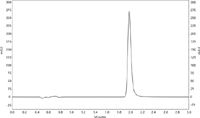UHPLC-UV Method for the Determination of Esomeprazole Using a Syncronis C18 1.7 ?m Column
The Application Notebook
This application note demonstrates the use of the Thermo Scientific Syncronis C18 1.7 ?m column for the determination of esomeprazole by UHPLC-UV.
This application note demonstrates the use of the Thermo Scientific Syncronis C18 1.7 µm column for the determination of esomeprazole by UHPLC-UV.
One of the key goals for the chromatographer is to achieve a consistent, reproducible separation. The selection of a highly reproducible HPLC column is essential if this goal is to be attained. The Syncronis™ column range has been engineered to provide exceptional reproducibility due to its highly pure, high surface area silica, dense bonding and double endcapping, all controlled and characterized through the use of rigorous testing.
Esomeprazole is a protein pump inhibitor and works by decreasing the amount of acid produced in the stomach. It is prescribed for treatment of gastroesophageal reflux diseases such as heartburn. It is also used for the treatment of stomach ulcers caused by taking non-steroidal anti-inflammatory drugs (NSAIDs)
This application note demonstrates the successful analysis of esomeprazole using a Syncronis C18 1.7 µm column.
Sample Preparation
Working standard contained 50 µg/mL of esomeprazole in water.
Thermo Scientific Column
Syncronis C18 1.7 µm, 50 × 2.1 mm (P/N 97102-052130)
Thermo Scientific Accela UHPLC system
Flow rate: 0.4 mL/min
Column temperature: 30 °C
Injection details: 1 µL partial loop
UV detector wavelength: 302 nm
Backpressure: 450 bar
Mobile Phase
Mobile phase A: water + 0.1 % ammonia solution
Mobile phase B: acetonitrile
Gradient
Time (minutes) % B
0.0 20
0.50 20
2.00 70
Consumables
Fisher Scientific HPLC grade water (P/N W/0106/17)
Fisher Scientific HPLC grade acetonitrile (P/N A/0626/17)
Fisher Scientific HPLC grade ammonia solution (P/N A/3295/PB05)
NSC Mass Spec Certified 2 mL clear vial with blue bonded PTFE silicone cap (P/N MSCERT4000-34W)
Results
The analysis was performed on a Syncronis C18 1.7 µm, 50 × 2.1 mm column. As shown in Figure 1, esomeprazole was analyzed in less than 2 min. Table I shows the calculated results from six replicate injections.

Figure 1: Chromatogram of esomeprazole analyzed using a Syncronis C18 1.7 µm, 50 à 2.1 mm column.
Conclusions
The Syncronis C18 1.7 µm column successfully analyzed esomeprazole in less than 2 min. Replicate injections show stable and reproducible results. This demonstrates that Syncronis C18 is an excellent choice of column for the rapid analysis of esomeprazole, allowing high sample throughput.

Table I: Retention time and asymmetry results for esomeprazole
Thermo Fisher Scientific
Tudor Road, Manor Park, Runcorn, Cheshire WA7 1TA, UK
tel: +44 (0) 1928 534110

SEC-MALS of Antibody Therapeutics—A Robust Method for In-Depth Sample Characterization
June 1st 2022Monoclonal antibodies (mAbs) are effective therapeutics for cancers, auto-immune diseases, viral infections, and other diseases. Recent developments in antibody therapeutics aim to add more specific binding regions (bi- and multi-specificity) to increase their effectiveness and/or to downsize the molecule to the specific binding regions (for example, scFv or Fab fragment) to achieve better penetration of the tissue. As the molecule gets more complex, the possible high and low molecular weight (H/LMW) impurities become more complex, too. In order to accurately analyze the various species, more advanced detection than ultraviolet (UV) is required to characterize a mAb sample.

.png&w=3840&q=75)

.png&w=3840&q=75)



.png&w=3840&q=75)



.png&w=3840&q=75)














